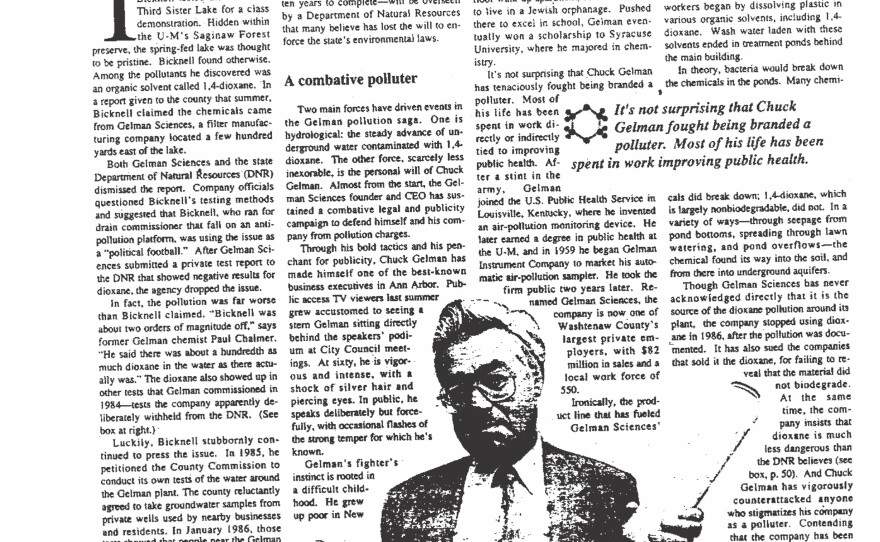In our previous 18-installments on the Ann Arbor area’s 1, 4 dioxane plume, we’ve heard from citizens, scientists, and government officials; both locally and from other dioxane sites around the country. Meanwhile, requests for interviews with the “Responsible Party”—Gelman Sciences, Pall Corporation or Danaher, are all met with silence. In this episode of “The Green Room,” we learn, that wasn’t always the case.
David Fair (DF): This is 89-1 WEMU, and I’m David Fair. At first, the company responsible for Ann Arbor’s dioxane plume was far from silent. In the three decades since the pollution was first discovered there have been a lot of changes. At this point, Pall-Gelman chooses to have no contact with the public. How did we get here? That question is the focus Barbara Lucas’ report in this edition of “The Green Room.
Barbara Lucas (BL): Ken Garber wrote about Gelman Sciences for the Ann Arbor Observer from 1992 to ‘97.
Ken Garber: I just reread them…
BL: You might think a story about groundwater pollution would be dry, but Garber’s articles are filled with drama, largely thanks to Gelman Sciences founder Chuck Gelman.
Garber: No one would dispute the fact that he was extremely confrontational, …especially after the state listed Gelman Sciences as the #2 polluter in the state.
BL: That was in 1986.
Garber: He began a long campaign not only to fight the charges, but to discredit his perceived enemies.
BL: Apparently, Gelman’s fight took many forms: lawsuits, lobbyists, speeches, paid ads. Gelman even paid a University of Michigan professor $75,000 to write a book.
Garber:Gelman Sciences became a publishing house in order to produce a book on the risks and health effects of 1,4-dioxane.
BL: What did that 1989 book conclude was a safe level of dioxane for drinking water? 3,400 ppb. In the 1990s, changes in Michigan’s legislature went Gelman’s way, and the amount of dioxane allowed in water was increased over twenty-five-fold.
Garber: So the politics—the change in administration from Blanchard to Engler—definitely favored the corporate sector in terms of environmental legislation.
BL: But the lack of progress on the cleanup wasn’t appreciated by the feds.
Garber: The EPA was pretty close to putting its foot down and saying, ‘Enough of this dithering with no clean up all these years. We're going to step in and clean it up ourselves, and make the polluter pay for it under the Superfund law.’ And this may have been important in pressuring Gelman Sciences to finally come to a Consent Agreement with the state, so that there would be no federal EPA supervision, and the company could do the cleanup itself.
BL: Garber’s 1997 article introduces Kim Davis, who was CEO and President of Gelman Sciences for 5 years, during its sale to the Pall Corporation. Davis tried to mend bridges with the community. Here are clips from his comments at a 1995 public meeting.
Kim Davis: I personally wanted to begin the process repairing what I felt were damaged relationships with the community. And I wanted to re-establish Gelman Sciences as a good corporate citizen. …We are doing what we are doing because it is the right thing to do. …critically important that we begin remediation at the core area right now. Every day that we don't pump that water out it and treat it, the problem gets worse and I'm not going to tolerate that anymore. …Now further, I’ve agreed to chair an ongoing working group which is going to include township residents and township trustees. …And we are proud to be here together to solicit public comment on the proposal to the MDEQ.
BL: But efforts to clean up the dioxane were less successful than Davis had hoped. His task force disbanded. Davis left Gelman Sciences in 1998.
Garber: Twenty-four years after I started reporting on this issue, it's not only not resolved, but it's actually worse. And that strikes me as a huge failure on our part, everyone's part—the public, the public officials, news media, the corporate people who are now technically responsible for the pollution, regulators—we've all failed the community. …Can't we do better than this?
(BL): Barbara Lucas, 89 One, WEMU.
(DF): The Michigan Department of Environmental Quality recently announced that representatives from Pall-Gelman-Danaher will attend upcoming task force meetings. Stay tuned as we continue to cover this ongoing issue, “The Green Room” is a presentation of the WEMU news department. Visit the archive on our website at wemu-dot-org to listen to the first 18-installments of our series on the Ann Arbor Area’s 1,4 dioxane plume. I’m David Fair, and this is 89-1 WEMU.





